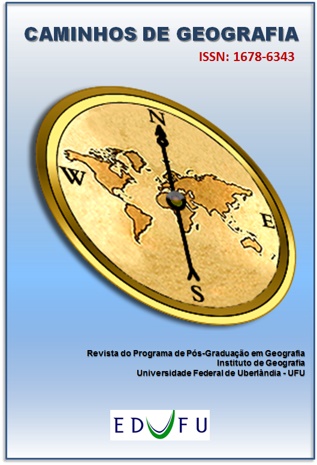STRUCTURE, DIVERSITY AND SIMILARITY OF WOODY COMPONENT IN SAVANAS WOODLANDS IN THE SOUTHWEST OF GOIAS –BRASIL
DOI:
https://doi.org/10.14393/RCG238658273Keywords:
Vegetation, Floristic, PhytossociologyAbstract
The presente work had an objective to know the structure, diversity and similarity of savannas woodlands in the southwest of Goiás. Therefore, 25 plots (400m²) were sampled to each community. Only trees with circumference at breast height (CBH) ≥ 15,7cm were measured. It was calculated the main phytosociological parameters, histograms of height and diameter classes were, in addition to Shannon's diversity index and Pielou's equability. A venn diagram was constructed and detrended correspondence analysis was performed to verify similarity. The total richness was 204 species, Fabaceae was the most representative with 24. The community of Montes Claros de GO presented the further structured savanas, with more mature trees and larger basal area. The communities of Rio Preto and Ouroana, on the other hand, presented a composition more related to generalist and pioneers species, with denser structure and smaller basal area. The indexes of diversity and equability were considered high in the three communities, showing low ecological dominance of some species over the others. The three locations were very similar floristically with low species substitution from one community to another. The results held that the studied communties contained a significant amount of the domain's biodiversity, with their conservation is imminent.
Downloads
Downloads
Published
How to Cite
Issue
Section
License
Copyright (c) 2022 Daniel Salgado Pifano, Michellia Pereira Soares, Fabiano Guimarães Silva, Erilva Machado Costa, Jullyanna Nair de Carvalho, Fabrício Alvim Carvalho

This work is licensed under a Creative Commons Attribution-NonCommercial-NoDerivatives 4.0 International License.
Autores que publicam nesta revista concordam com os seguintes termos: a) Autores mantém os direitos autorais e concedem à revista o direito de primeira publicação, com o trabalho licenciado sob a Creative Commons Atribuição-NãoComercial-SemDerivações 4.0 Internacional. b) Autores têm permissão e são estimulados a publicar e distribuir seu trabalho online (ex.: em repositórios institucionais ou na sua página pessoal), já que isso pode gerar alterações produtivas, bem como aumentar o impacto e a citação do trabalho publicado. c) Em virtude de aparecerem nesta revista de acesso público, os artigos são de uso gratuito, com atribuições próprias, em aplicações educacionais e não-comerciais.











